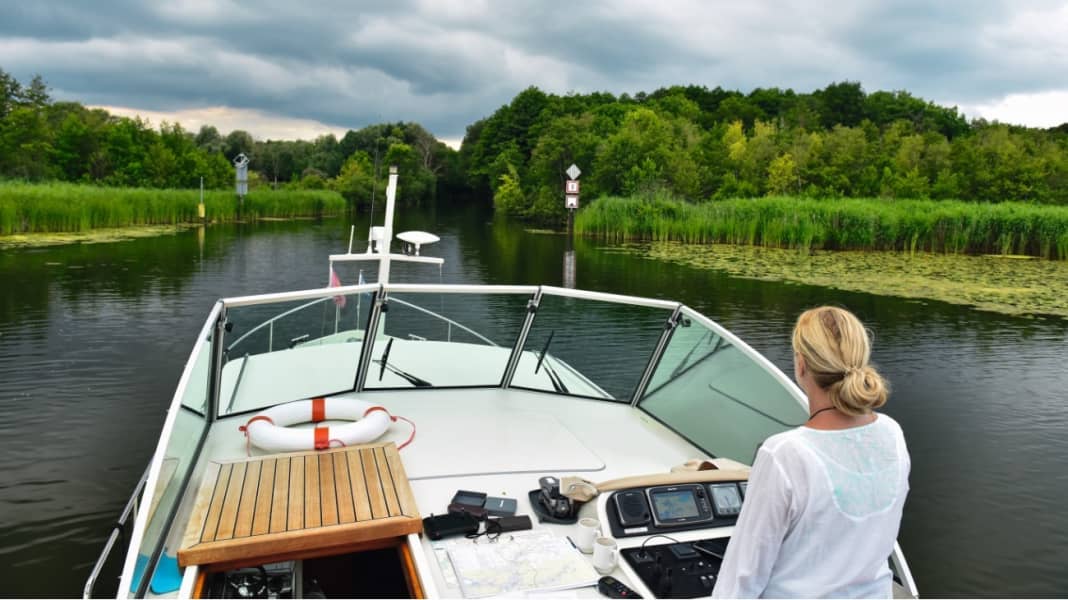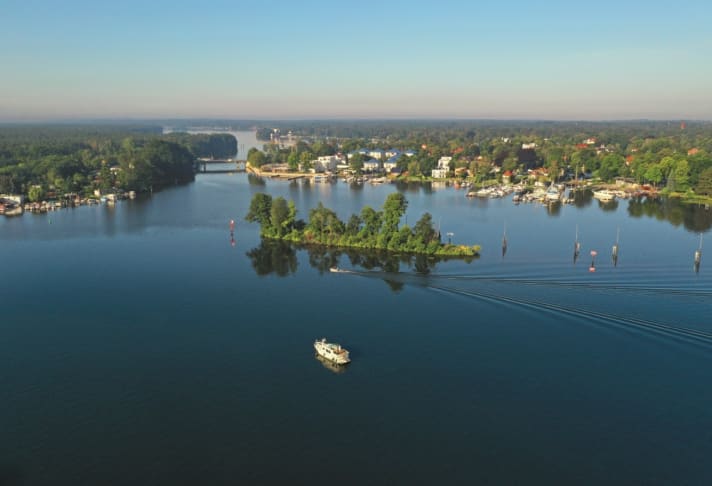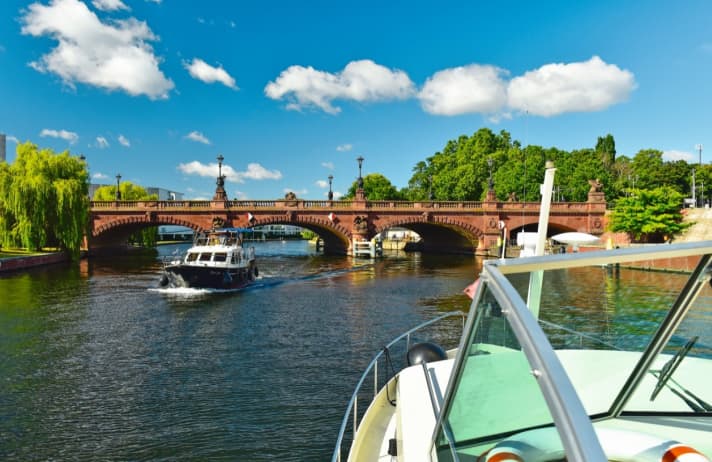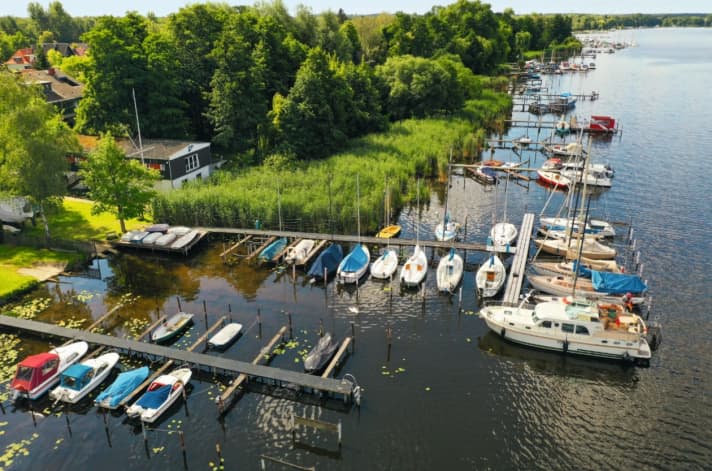
No other metropolis in Europe has such a fascinating water sports area to offer as Berlin. Even Venice, with 38 kilometres of navigable canals, looks modest in comparison. The German capital has almost five times as many navigable waterways, specifically 182 kilometres within the city limits of Berlin. If you add the waters of the Mark Brandenburg, there are over 400 kilometres of navigable rivers, lakes and canals.
Where are the most beautiful boating areas in Berlin? There are three completely independent regions, each of which begins in Berlin and extends beyond the city limits into Brandenburg. The areas of the green hinterland are connected by inner-city waterways. One of these is the Spree, which runs through the centre of Berlin.
Need more information? You can find the article "Berlin's green expanse" with lots of pictures, nautical area data and a large service section in BOOTE issue 12/2020 from 18 October 2020 at newsstands or online at Delius Klasing Shop.
The largest water sports paradise on the outskirts of the capital is the lake district in the south-east, which is criss-crossed by the rivers Dahme and Spree. There are over 40 clear lakes here, nestled in a green landscape that becomes increasingly sparsely populated the further east you travel. Müggelsee and Scharmützelsee are among the largest and best-known lakes in the region. The lakes are connected by canals built over a hundred years ago and are now a unique paradise for boating tourism.
The second district is located in the north of the capital and is fed by the Havel. It begins north of the Spandau lock. The best-known lakes are Tegeler See and Nieder Neuendorfer See. Towards the north, the boating area extends beyond the city limits to Hennigsdorf, which already belongs to Brandenburg.
Berlin's third water sports Eldorado is the Lower Havel south of Spandau. The best-known lakes here are the Große Wannsee and the Jungfernsee, the southern part of which already belongs to Brandenburg. To the south-west of Potsdam is the uniquely beautiful lake district of the Potsdam Havel.
The three green water sports areas on the outskirts of Berlin have another special feature. Not only are they navigable via the city centre canals, they are also part of the European waterways network. From the lake district in the south-east of Berlin, you can continue on to the Oder and thus to Szczecin. From the district in the north of Berlin, you can continue on to the Mecklenburg Lake District, and from the Potsdam Havel to the south-west of Berlin, the waterways lead on to the Elbe. The trip we took is therefore just one of many possible routes you can take if you hire a boat in the capital.
Need more information? You can find the article "Berlin's green expanse" with lots of pictures, nautical area data and a large service section in BOOTE issue 12/2020 from 18 October 2020 at newsstands or online at Delius Klasing Shop.
We take delivery of a Linssen Grand Sturdy 36.9 AC in Berlin-Köpenick and are delighted from the very first moment. The boat offers plenty of space and is easy to steer, even with a small crew, thanks to the bow and stern thrusters. From our berth opposite Köpenick Castle Island, we steer around the town hall and into the Müggelspree.

The most famous Köpenicker is honoured with a life-size statue in front of the town hall. His name was Friedrich Wilhelm Voigt and he was not an honorary citizen, but a crook, petty criminal and conman who spent most of his life in prison. Yet he still gets a memorial? Yes, and his own museum in the town hall! With a borrowed uniform and obedient soldiers, he stole the town treasury on 16 October 1906 and went down in German history as the Captain of Köpenick.
After three kilometres, we reach our destination for the day, the SpreeArche. A wooden ark is actually floating on the water in the cosmopolitan city of Berlin, gilded by the most beautiful evening light. Will we be allowed to moor? A young man takes our lines. His name is not Noah, but Frank Cotte. In 2013, he had a Dutch company cast a concrete float, built a wooden ark on top of it and anchored it in a bay on the Müggelspree. The authorities were up in arms. Cotte had no licence for anything. But the man has a thick skin and, as this is already his second ark, he also has experience with the authorities.
To ensure that no one can dig up the ark's water for ecological reasons, its cellar is full of innovative technology. Drinking water that is cleaner than Berlin's tap water is extracted from the Spree. And the waste water from the restaurant and toilets is purified in a multi-stage treatment plant so that it is cleaner than the water in the river before it is discharged into the Spree. The modern-day Noah had to weather his worst storms in offices and courts. But he and his ark defied all storms. Today, the Köpenicker SpreeArche is one of the most popular places to eat and celebrate in a unique atmosphere. Guests with boats are welcome ( www.spreearche.de ).
In the morning, we stop to do some shopping at the Friedrichshagen sports boat harbour, which is just before the exit to Müggelsee. The jetties are a little small for our charter boat. It's just a few steps from the jetty to Germany's best-known discount supermarket. With a full fridge, we cross the Großer Müggelsee and pass the small lagoon town of Neu Venedig. Unfortunately, the sky is grey and the charm of the settlement, which is criss-crossed by canals, doesn't really come across. In the Dämeritzsee to the east, we head north-east, pass the Flakensee and reach the Woltersdorf lock. It forms the gateway to the upper part of the Rüdersdorf waters.
There has been a barrage for shipping here since the 16th century. The reason for this is the lime deposits near Rüdersdorf, which have been used as a building material for 800 years. In pre-industrial times, barges and ships were the only means of transporting heavy bulk goods in large quantities. With the construction boom in Berlin at the end of the 19th century, such large quantities of limestone, quicklime and cement were needed that the waterways from the Rüdersdorf lime mines to the centre of Berlin had to be expanded to provide a high capacity. In this context, the new Woltersdorf lock was built in 1882.

Today, it is rare to see a ship loaded with lime sailing on the waters of Rüdersdorf. The town of Rüdersdorf, which looked unsightly and grey until the fall of the Berlin Wall, is becoming a popular place to live by the water. Most of the industrial plants have been decommissioned. In the centre of the town, where lime was once burned, you can now visit the extensive Rüdersdorf Museum Park. Since September 2020, the museum park has even had its own marina ( www.ruedersdorf-kultur.de ).
Need more information? You can find the article "Berlin's green expanse" with lots of pictures, nautical area data and a large service section in BOOTE issue 12/2020 from 18 October 2020 at newsstands or online at Delius Klasing Shop.
In the most beautiful evening light, we sail back down the waters of Rüdersdorf, turn into the wildly romantic Gosen Canal in Dämeritzsee and cross Seddinsee in the last light of the day. Although it is peak season, we can count the pleasure craft on one hand. All around us is forest and solitary nature. The chattering of geese and other bird calls are the only sounds we hear. We drop anchor in the south of the lake. It feels as if we have arrived in an exotic natural paradise. But our anchor is in the 9th district of Berlin.
With a view of the Müggelturm tower, we head down the Dahme in the morning. Soon the banks are built up: Magnificent villas alternate with water sports clubs. In Köpenick, we turn from the Dahme into the Spree and then downstream towards the city centre. From here, the banks are completely built up. Old industrial buildings in red brick dominate, some of which have been converted into flats with lake views. Other areas are being demolished and rebuilt. Not much remains of the commercial enterprises from the Wilhelminian era and the GDR. Loft living by the water is now the order of the day.
We pass Lake Rummelsburg, where an alternative houseboat scene has established itself, turn off to port towards the Island of Youth and get the last free guest berth at the KLIPPER sailing ship restaurant. The terrace built around the traditional sailing ship is packed and we haven't made a reservation. I tell the waitress that, as there is no table available, she can serve our meal on board. She's friendly about it. Both the smoked fish with fried potatoes and the vegetable stir-fry are delicious. In future, I would reserve a berth and table (tel. 030-532 164 90).
Our second spot in the green surroundings of Berlin is Nieder Neuendorfer See in the north of the capital. The route there leads right through the centre of Berlin. And it's well worth a visit. Between 10.30 a.m. and 7 p.m., only vehicles equipped with VHF radio may pass through the city centre. Our charter boat is equipped with a radio. At rush hour, however, the Spree is full of excursion boats and a slow-moving pleasure craft is more of a traffic obstruction. We don't want to do that to ourselves.

We therefore first head towards Mühlendammschleuse and shortly before that turn to port into the Spree Canal. We pass the fleet of vintage boats in Berlin's historic harbour on our left. The sports boat mooring is located in the Spree Canal behind two low arched bridges. Will we fit through? We lay the mast. There is barely a hand's breadth of space between the Linssen and the arch of the bridge. To my astonishment, there is only one other pleasure craft moored at the public jetty next to the famous Museum Island. If you're interested in historic Berlin, art and culture, this is the place to be.
Need more information? You can find the article "Berlin's green expanse" with lots of pictures, nautical area data and a large service section in BOOTE issue 12/2020 from 18 October 2020 at newsstands or online at Delius Klasing Shop.
At 7am we drive through Mühlendammschleuse and are in the heart of Berlin. The excursion boats are not yet sailing. It is quiet on the water. We calmly pass the rebuilt Hohenzollern Palace, now called the Humboldt Forum, the cathedral and Friedrichstraße railway station. A berth is just becoming available at the Schiffbauerdamm jetty. We moor up and have breakfast with a view of the Reichstag and the Federal Chancellery. Shortly before 10 a.m., the first excursion boats arrive, giving us a foretaste of how turbulent the Spree will soon be.
We cast off, leaving the Reichstag and the Federal Chancellery on our port side. From the main railway station onwards, the Spree becomes quiet again. We pass the Charlottenburg lock and in the early afternoon we are in the tailwater of the Spandau lock, where we join a crowd of waiting pleasure craft.
Above Spandau, the banks of the Havel quickly become green again or are built up with villas. In the evening, we reach Nieder Neuendorfer See, the most beautiful body of water in the north of Berlin. Strictly speaking, it is a widening of the Havel coming from Mecklenburg-Vorpommern. The water is very clean and inviting for a swim. A stone's throw north of the lake is the town of Hennigsdorf in the state of Brandenburg. There are guest moorings in the north-west yacht centre and in the town harbour. We are lucky and get a guest berth at the Heiligenseer Segel-Club e.V. in the north-east of Nieder Neuendorfer See, where we are warmly welcomed. In the north-west of Nieder Neuendorfer See, where the Havel Canal branches off from the Upper Havel Waterway, the embankments of the former border crossing point were removed and renaturalised after reunification. This area is now a breeding ground and refuge for seabirds. Even if you can see the television tower in the distance, the north of Berlin is a unique natural paradise.

We point the bow southwards, aiming for the waters around Potsdam. Unfortunately, we have to wait two hours in Spandau. Theoretically, we could sail south into the evening, but we need a marina that not only has fresh water, but also a faeces extraction system.
Marina Lanke is located four kilometres south of the Spandau lock on the west bank. This family-run business is in a very beautiful and quiet location and offers every service for boats. We are given a friendly welcome late at night and can have the tank pumped out in the morning ( www.marina-lanke.de ).
Need more information? You can find the article "Berlin's green expanse" with lots of pictures, nautical area data and a large service section in BOOTE issue 12/2020 from 18 October 2020 at newsstands or online at Delius Klasing Shop.
The lake district of the Lower Havel begins south of the Scharfe Lanke. We are back in the city centre of Berlin - but everything around us is green. The villas on the banks are fewer and fewer. Only the Grunewald Tower remains in view as a landmark.
On the Jungfernsee, we cross the border into Brandenburg and are immediately in the city centre of Potsdam with its magnificent Prussian buildings. To the south is the lake district of the Potsdam Havel. Once again, everything is green all around. Only occasionally does the top of a Brandenburg church tower rise into the steel-blue sky. The crowning glory of our trip is the town of Werder, where we are given a guest berth at the Einheit Werder sailing club. We are moored in the historic island town with its many pubs and plenty of culture.
Via the Sacrow-Paretz Canal, we complete the circle around Potsdam, where we moor for the last night on the southern shore of the Jungfernsee. We take the shortest route back to Köpenick via the Teltow Canal. What remains is the memory of a beautiful trip through the incredibly green landscape on the outskirts of Berlin.

